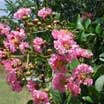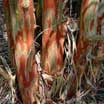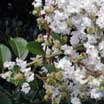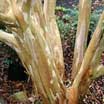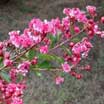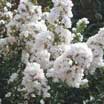Arkansas Crapemyrtle Database
The crapemyrtle is native to Southeast Asia. The fact that crapemyrtles have the potential for a long flowering period (up to 120 days) in the summer has given rise to the popularity of this plant in our state.
Breeding programs in USA and Europe have generated in the last three decades a wide range of plant sizes (from 2' dwarfs to 30' tall trees), growth habits (broad, upright, weeping, etc..), cold hardiness (Zones 6-10), disease resistance (powdery mildew and leaf spot) and a wide range of bark characteristics, flower color and fall color.
Crapemyrtle breeding history
Out of all the Lagerstroemia species, L. indica is the most widely known and cultivated. The rather obscure and perhaps nearly extinct L. fauriei, found only in the island of Yakushima, Japan has brought the most significant developments in the breeding of modern ornamental Lagerstroemia cultivars, contributing mainly with powdery mildew resistance, cold hardiness and attractive bark Many cultivars have been introduced by the U.S. National Arboretum including: 'Pocomoke', 'Acoma', 'Caddo', 'Hopi', 'Tonto', 'Cherokee', 'Osage', 'Sioux', 'Tuskegee', 'Tuscarora', 'Biloxi', 'Kiowa', 'Miami', and 'Natchez'. Introductions by the University of Arkansas include: 'Centennial', 'Hope', and 'Victor'.
Pruning Crapemyrtles
Dehorning (or topping) is, sadly, a widespread pruning practice applied to many crapemyrtles. Fortunately the plant can withstand such abuse. Proper selection of the right cultivar (i.e. size and growth habit) should take priority over improper pruning if this is justified by space considerations. Contrary to popular beliefs, excessive pruning in crapemyrtles does not induce heavier flowering, but rather detracts from it due to the likely removal of significant plant carbon and nutrient (i.e. food) reserves.
Proper pruning of the shrub or tree types includes selectively removing branches back to a branch (thinning). Crapemyrtle flowers on new stems/wood so plants can be pruned until late spring without reducing flowering that summer.
Crapemyrtle Diseases
There are two serious and common fungal diseases on crapemyrtle: powdery mildew (Erysiphe lagerstroemiae) and Cercospora leaf spot. In Arkansas, the more serious disease is leaf spot which can cause susceptible varieties to be nearly defoliated by late August. While chemical controls could be used, we encourage planting varieties that are less susceptible to both of these diseases.
Crapemyrtle Insects
A new, and serious insect was discovered in Arkansas in 2014. Currently called ‘crapemyrtle bark scale’, this aggressive insect pest causes significant aesthetic issues for crapemyrtles. Learn more from our fact sheet Crapemyrtle Bark Scale: A New Insect Pest – FSA7086.
Metallic green flea beetle (Altica sp.) is noted as a serious insect pest in many southeastern states it does not appear to be a serious problem on crapemyrtle in Arkansas yet.
